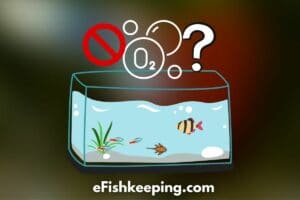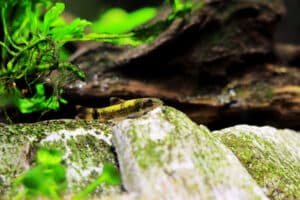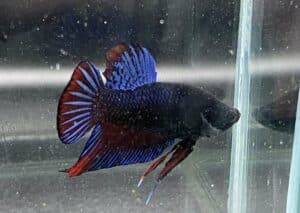Angelfish are a gorgeous addition to any aquarium! However, there are many problems which can cause troubles even in the happiest aquarium.
The most common reasons why angelfish keep dying are changes to their water, the conditions of their tank, stressful situations, and sicknesses which the species is prone to. Ensuring that an angelfish has proper hardness in their water, the correct pH balances, and is not facing any undue aggression from tank mates is the best way to prevent death.
Though it can be hard to narrow down exactly which dangers your angelfish might be suffering from, we’ve prepared a guide to the 9 most common reasons.
In this article, we’ll also give you a look at how to tell if your angelfish is dying, whether or not you can save it, and some answers to frequently asked questions. With so much to cover, let’s get started right away!
Why Do Angelfish Keep Dying?
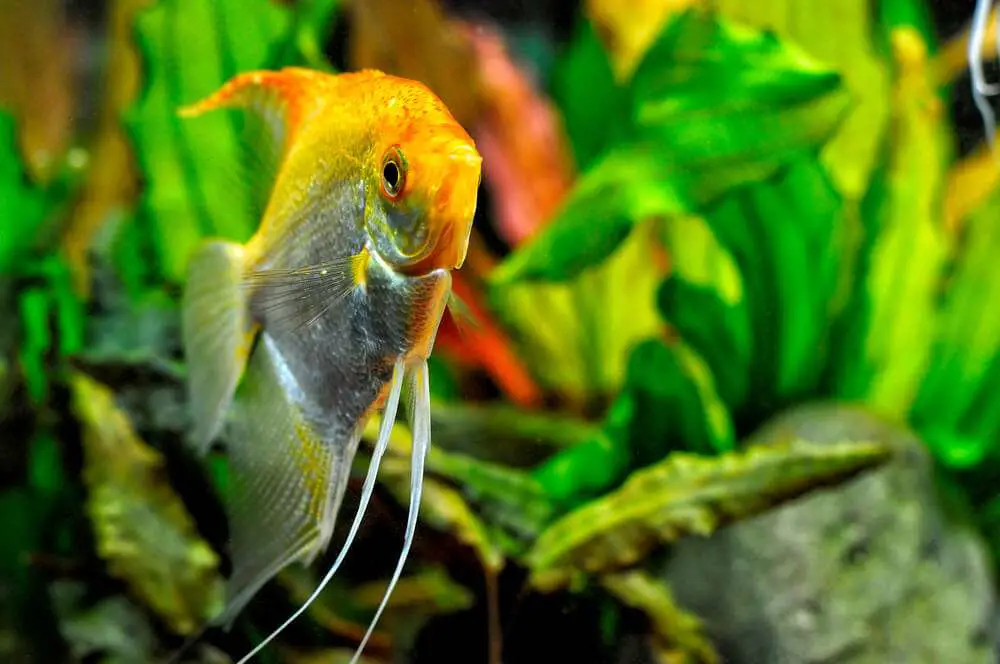
1. Incorrect Water Temperature
Improper water temperatures for an angelfish can result in rapid decrease of health and even death.
Your angelfish is not able to regulate its own body temperatures as well as a mammal might. For this reason, it is up to you to make sure that the tank stays in the safe zone in terms of water temperature.
The optimal water temperature for an angelfish is 78 to 84 degrees Fahrenheit. And the best way to do this is by purchasing a reliable aquarium water heater like this one – Fluval E Series heater (available on Amazon).

You can check out my detailed review about Fluval E Series Heaters here.
2. Incorrect Tank Chemical Balance
Your angelfish can survive if your tank does not have the best chemical balance, but not for very long. Water chemical balances that are too hard or lacking in the correct pH levels can lead to disease and ultimately the death of your angelfish.
Your angelfish’s water should have a pH balance between 6.5 and 7.5. The water hardness should remain between 5 o to 130 in terms of GH.

I recommend you get a tank water test kit like this one from Amazon for regularly testing the water conditions of your aquarium.
3. Poor Choice of Tank Mates
There is a lot that should go into selecting the best tank mates for an angelfish.
Some people who are new to the aquarium life may mistakenly choose fish that simply need the same or similar environments to the angelfish.
While this is one category of requirement, it is not the only requirement that should be considered for the health of your angelfish when selecting tank mates!
Tank mates that are too aggressive or too competitive for food can lead to the untimely death of your angelfish.
For instance, angelfish who are too stressed by the competition they may face for food at the top of the tank could wind up dying of starvation. So in that case, a proper tank mate for an angelfish would be one that dwells in the lower zone of the tank
Though angelfish are large and aggressive enough to eat or bully fish smaller than themselves (anything under 2 inches long) they can also become victims to fish that are too large. Any fish that gets much larger than 10 inches long can become a threat to your angelfish’s safety.
Therefore, the best fish to get as tank mates for your angelfish are Corydoras catfish, Boesemani rainbow fish, Mollies, plecos, or even Kribensis. These fish are big enough to avoid being bullied by the angelfish, yet too small to cause undue stress.
4. Poor Filtration
One of the most important issues facing angelfish is a lack of filtration in their tank. Filtration just refers to getting all of the natural debris in the water strained out so that your fish is swimming in a good environment.
You can filter your tank for your angelfish in a variety of different ways.
One of these is chemical filtration. This involves adding zeolite or carbon to the water to soak up ammonia and other toxic compounds in the water.
Another type of filtration is mechanical. Getting a filter that can physically sift out the debris in the water column of the tank is very helpful.
Finally, possibly the best and most important type of filtration is the biological filter. A biological filter not only removes the bad elements in tank water, but adds stabilizing compounds at the same time.
If you are purchasing a filter, consider getting a canister filter, which hangs on the back of the aquarium to provide biological, mechanical, and chemical filtration by the use of powerful tubes.
5. Poor Oxygenation
Typically, if you have poor filtration in your tank, you also have poor aeration. This means the oxygen levels in your fish tank are not high enough for your angelfish to survive. Some fish owners decide to get an aeration device, such as a bubbler – also known as air stone, to help with this problem.
However, if you have a great filter like the canister filter, it should disturb the water enough to solve your oxygen problem at the same time.
Without the correct oxygenation of water, you may notice your angelfish hovering near the surface or exhibiting gasping behavior. Make sure you have the best filter money can buy to guarantee that your angelfish is not going without proper aeration.
6. Bacterial Infections
All fish can suffer from bacterial infections and their unpleasant symptoms, many of which lead to death. Angelfish are no exception to this danger. Below are a list of the common bacterial infections an angelfish can get:
- Angelfish Dropsy – This disease can cause fluid to build up in your angelfish as a result of damaged kidneys. Symptoms include protruding scales, lethargy, bloating, and bulging eyes. If you catch it quickly enough, you can add antibacterial medicine to the fish’s food and draw the fluid out in a separate tank.
- Fin Rot – If your water conditions are sub-optimal, your angelfish could get fin rot beginning in the tips of fins and progressing toward the base. This looks like shredding, difficulty moving, and opaque whiteness in the scales. You should clean the tank, change the water, and apply antibiotics to the fish. Keep them away from nipping tank mates!
- Mouth Fungal Disease – This disease only strikes when an angelfish is wounded, and results in fluffy threads of white around the face, sores, difficulty breathing, mucus, and even ragged fins. Applying antibiotics such as phenoxyethanol and kanamycin, and salt treatment can help in the treatment.
7. Parasitic Infections
It is very unpleasant to discuss, but angelfish are prone to parasitic infections that can lead to their deaths. Take a look at the most common parasitic infections in angelfish as well as symptoms and remedies below:
- Angelfish Ich – This is also called “White Spot Disease.” Sudden changes in temperature cause angelfish to be prone to a parasite that causes white spots, difficulty eating and breathing, and folded fins. To treat ich, apply anti-parasite medicine to the tank and raise the temperature of the water to 86 degrees Fahrenheit.
- Gold Dust Disease – Also called ‘Velvet Disease,’ the parasite causes the angelfish body to look covered in gold or green cysts. The angelfish may have difficulty doing much of anything. It is highly contagious. Treat by isolating the angelfish in a blacked-out tank and treat the warm water with salt and copper sulfate.
- Hexamita – Also called ‘Hole in the Head Disease.’ True to the name, the parasite causes your fish to have sores on the head, a lack of color, no appetite, and stringy poop. Quarantine affected angelfish, heat the water to 90 degrees slowly, and then treat the quarantine tank with MetroPlex.
Though there are more parasitic infections an angelfish can suffer from, these are the top three that can lead to death.
8. Diseases
Outside of the above-mentioned bacterial diseases and parasitic diseases, other sicknesses that an angelfish may suffer from include:
- Anchor worms – If you notice ulcers or actual worms at the fish fin’s base, they likely have anchor worm disease. Use a potassium permanganate bath to eliminate baby anchor worms, gently remove embedded worms, and treat the fish tank with salt or a chemical called Dimilin to solve the problem.
- Angelfish AIDS – This is an intensely contagious disease that can kill your angelfish in a matter of days. It causes an upturned nose and weakness. You can quarantine your fish and treat the tank with Seachem Para Guard with a 10% change in water between each three-day treatment.
9. Incorrect Feeding Procedures
Last but not least, we all know that living things need the proper nutrition to survive. If your angelfish is dying, one of the first things to check is their diet and eating habits. In the wild, an angelfish will eat an omnivorous diet, meaning they eat living things and plant life.
You can copy this diet by giving your fish the correct amount of vitamins and minerals in the form of commercial fish foods like pellets and fish flakes.
Keep your angelfish interested in daily feeding time by surprising them with variety every once in a while. Add in frozen or live foods like insects. It is also important to note that an angelfish should be fed only twice a day, at maximum.
Give them only enough food that can be consumed in under 4 minutes to reduce the risk of overeating.
Check out this guide to learn about angelfish feeding frequency and more.
How to Tell if Your Angelfish is Dying?
To tell if your angelfish is actually dying, look at the table below:
| Signs of a Healthy Angelfish: | Signs of a Dying Angelfish: |
| Upright fish in control of its own position in the water column. | Difficulty remaining buoyant: sitting on the floor of the tank or floating the wrong-way up. |
| Energetic swimming. | Lethargy, lack of direction, and weakness. |
| Regular eating and excitement during feeding time. | Lack of interest in food and lack of appetite. |
| Bright, slightly protruding eyes. | Cloudy eyes or eyes that are sunken. |
| Whole fins with complete range of motion. | Tattered, torn, missing, or swollen fins that barely move. |
Is it Possible to Revive a Dying Angelfish?
So you’ve noticed some of the above symptoms in your angelfish, and now you’re hoping to save the little swimmer. Is it possible? The truth is, yes, in some cases, even if you notice sunken eyes, tattered fins, or a lack of appetite in your angelfish, you may still have a chance of saving them.
In the cases of the above-mentioned diseases, you can, oftentimes, treat the sickened angelfish and hope for a better outcome.
For example, even in Angelfish AIDS, one of the most deadly and contagious diseases, all hope isn’t lost. It takes considerable care, but the key is to catch the sick fish’s symptoms early and act very quickly when treating the problem.
However, many medications are administered through feeding. If your fish’s illness has progressed to the point where it cannot or will not eat, sometimes there is simply nothing you can do to save the angelfish.
Luckily, in the cases of other problems that have to do with water conditions or environments, hope is much stronger!
Pay attention to your angelfish’s tank mates and simply remove hostile presences to reduce stress. Then see if your angelfish begins eating or swimming regularly. If not, test the water conditions and temperature.
How to Prevent Angelfish From Dying?
Below, we’ll take a look at the top 5 tips to keep your angelfish from dying, just so you can be sure you’re doing everything you can to ensure your fish’s health!
- Test Water Frequently – Using pH strips, make sure to test your angelfish’s water every two to three days for acceptable water values. This is especially important if you just performed a water change!
- Perform Water Changes Regularly – For the best conditions, you can change your angelfish’s water at 10 percent every week, or 25 percent every other week.
- Keep Hiding Places Available – Make sure you add in ferns, moss, sword plants, and other plants that are compatible with angelfish. Not only is this a great way to reduce stress by giving them places where they can hide and feel safe, but these plants also add good bacteria to the tank’s overall ecosystem!
- Get Other Angelfish – Though angelfish are technically cichlids, which are known for infighting, angelfish actually like shoaling with their own kind. This makes them feel safer. Consider purchasing one to two more angelfish of the same breed, but make sure the tank size is large enough for all to live at peace.
- More Live Food in the Diet – While angelfish can survive on omnivorous diets and pellets, as well as frozen food, you can lower the death rate by feeding them brine shrimp, guppies, blackworms and bloodworms!
- Watch Out For Parasites – It is difficult to monitor, but make sure that any live food or new plants you bring in from outside sources are not harboring parasites. Sometimes it is impossible to catch the parasites before they cause an infection, so be careful to watch your angelfish for signs of parasitic infection, as listed above.
FAQs:
Below is a list of answers to frequently asked questions!
How long do angelfish live?
A healthy angelfish can live for up to 10 years if cared for properly.
Are angelfish hard to keep?
Angelfish are not hard to keep once their environment is set up correctly. As long as your routine of regularly cleaning the tank without overdoing it on feeding or water changes is in place, an angelfish is not a hard animal to keep alive and healthy!
Why did my angelfish die after water change?
A water change that swaps out more than 60 – 70% of the water in your angelfish’s tank is almost impossible to accomplish without causing a giant change in your fish’s environment. This change can affect all of the chemistry your fish is used to living in.
For this reason, stick to only changing 25% of your angelfish’s water out every other week, at most, to avoid the sudden death of your fish.
Angelfish stopped eating and died: why?
An angelfish may stop eating for several reasons, but the most common include disease or food competition. If your angelfish is affected by a parasitic infection, or the water conditions are leading them to be unable to digest properly, they may refuse to eat. An angelfish who can’t compete with improper tank mates may also stop eating and starve.
Why did my angelfish die suddenly?
Sudden causes of death in an angelfish include Angelfish AIDS, which is a disease that can kill your angelfish in as few as 2 to 3 days after infection. A water change that causes a drop or spike in water parameters outside of what your angelfish is used to, can also cause shock, leading to sudden death.
Wrapping Up
In short, the 9 most common reasons for angelfish to die include diseases, parasitic and bacterial infections, incorrect water conditions such as temperature, chemistry or filtration, poor tank mate choices, incorrect feeding procedures and poor oxygenation.
Though angelfish are relatively easy to care for, this is only if you are aware of the right water conditions, dietary needs, and infectious threats of an angelfish.
Often, the best catch-all to keeping your angelfish from dying is simply observation. Test and clean the water of the tank regularly and watch your fish for signs of disease or stress.
References:
- Angelfish Diseases, Parasites & Remedies – Smart Aquarium Guide
- Angelfish Tank Mates – Build Your Aquarium
- Amazing Angelfish – Tropical Fish Magazine
Hi! I’m Praveen Ghoshal, the founder of eFishkeeping.com. Inspired by my Dad, I got interested in fishkeeping when I was a kid. Since then, I have been involved with this hobby. Currently, I have 3 fish tanks at our home, and I enjoy this hobby with my full family. Read more about me here.

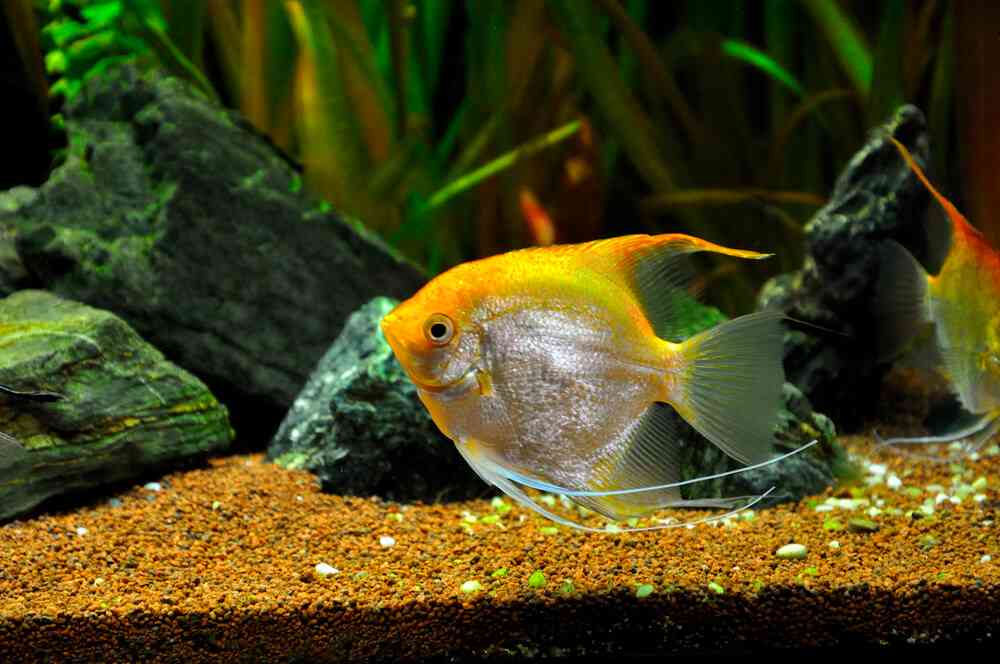

![Do Neon Tetras Die Easily? [Here’s The Truth!] do-neon-tetras-die-easily](https://efishkeeping.com/wp-content/uploads/2023/03/do-neon-tetras-die-easily-300x200.jpg)
